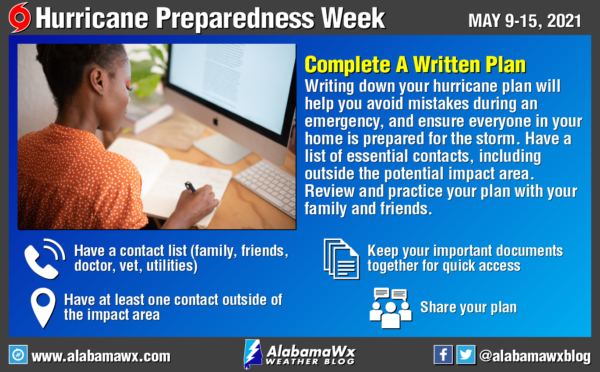Hurricane Preparedness Week – Day 7: Complete A Written Plan
Electricity will likely be disrupted and communication networks such as cell phones, computers, landline telephones, and the Internet may be affected during a disaster.
Having a family communications plan in place in ahead of the disaster can help ensure that everyone knows how to connect and where to meet during an emergency.
Use this checklist to complete your family communications plan today!
• Write down or capture telephone numbers and email addresses for everyone in your household. If you have children that do not have a cell phone, record the telephone number and email address for their school and/or daycare provider.
• Write down or capture telephone numbers for emergency services, utility provider, medical providers, homeowners insurance company, automobile insurance company, veterinarian, and any other service providers that you may need to contact.
• Become familiar with the disaster plans for your children’s school and their communication methods as a disaster can strike during school and/or work hours. Remember to discuss these plans with your children.
• Identify a family member or friend to serve as an out-of-state contact, so all family members have a single point of contact. Write down or capture two contact methods for this individual such as telephone, cell phone, e-mail address, or social media. Determine safe places where your family can go for protection or to reconnect if separated. Be sure these locations are accessible, and if you have pets, identify animal-friendly locations. Identify the following locations:
— Indoors: If you do not have a tornado safe room or storm shelter, the safest place may be a small, interior, windowless room such as a closet or bathroom on the lowest level of the structure.
— In your neighborhood: This is often where your family can meet if there is an emergency, and you need to leave your home. This could be a big tree, a mailbox at the end of your driveway, or a neighbor’s house.
— Outside of your neighborhood: This is often where your family can meet if there is an emergency when you are not home, and you can’t get back to your home. This could be a place of worship, library, community center, or a family friend’s home.
— Outside of your town or city: Having an out-of-town meeting place can help you reunite if a disaster happens, and you cannot get home or your family is separated. This is especially important if your community is instructed to evacuate the area.
• Once created, make sure everyone receives a copy of the family communications plan. Store copies of the plan in your purse, backpack, or cell phone. Remember to post a copy of your plan in a central location in your home such as the refrigerator or family bulletin board.
• Don’t forget to practice your plan!
Here are a few reminders and tips:
• Learn your family’s social media handles, and consider signing up for social media applications such as Facebook Safety Check, American Red Cross Safe and Well, and Google Person Finder.
• Remember, texting may work best before, during, and after a disaster as a text message may be more likely to reach the recipient as it requires far less bandwidth to send than making a phone call.
• Store at least one emergency contact under the names “In Case of Emergency” or “ICE” for all cell phones and devices. This will help someone identify your emergency contact if needed. Be sure to inform your emergency contact of any medical issues that you or your family members may have, and explore new tools such as the Medical ID option on Apple devices.
• To show why it is important to keep phone numbers written down, challenge your family members to recite important phone numbers from memory.
• Make sure that everyone, including children, knows how and when to call 9-1-1 for emergency help. Remember, only call 9-1-1 if there is a life-threatening emergency.
• Conserve your cell phone battery by reducing the brightness of your screen, placing your phone in “airplane” mode, and closing unnecessary apps that you do not need.
Helpful Links
• FEMA: Make a Plan
• FLASH: Family Disaster Plan
All information from: NOAA, FEMA, FLASH, The Red Cross, Alabama EMA.
Category: Alabama's Weather, ALL POSTS, Met 101/Weather History, Severe Weather, Tropical



















